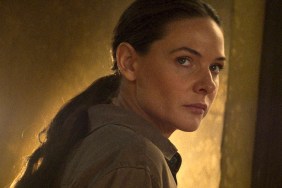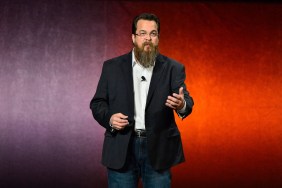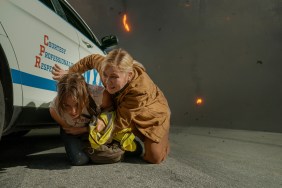Over the last few years, we’ve seen quite a few British filmmakers tackling the historic war epic, some of the more recent ones being Neil Marshall’s Centurion and Kevin Macdonald’s The Eagle. Both of those had their merits, but they don’t quite have the impact of Jonathan English’s Ironclad.
Branching off from the signing of the Magna Carta and the decision by King John to renege on his arrangement for peace and send his significant army against a small band of soldiers inhabiting Rochester Castle, the movie’s all-star ensemble cast of Paul Giamatti (playing King John), James Purefoy, Brian Cox, Sir Derek Jacobi, Jason Flemyng and Kate Mara take part in some of the most violent battles we’ve seen in quite some time. (If you don’t believe us, check out this insanely gory fan-made trailer, which features some of the most violent bits from the movie, but don’t say we didn’t warn you!)
Despite the gore, the subject matter is handled in a way that’s surprisingly reverential to the actual history, and it’s particularly impressive when you realize that English didn’t have anywhere near the budget Ridley Scott had for movies like Gladiator and Kingdom of Heaven while still pulling off a similarly epic scale for his battle sequences.
ComingSoon.net got on the phone with English a couple of weeks back to talk about his decision to tackle history
ComingSoon.net: What inspired you to tell this story? The signing of the Magna Carta is a fairly momentous event in British history and Rochester Castle is a real place that was invaded. What made you decide to put the two things together into this story?
Jonathan English: The main inspiration for it was actually visiting the real castle, which Rochester Castle actually still exists. Of course, it’s somewhat in a state of ruin, but it still exists about 15 miles outside of London as was shown in the film. I went to the castle about five years ago and walked around the castle and learned about this particular battle where King John already had signed the Magna Carta and then reneged on his pledge for peace, and then raised his army of mercenaries from Scandinavia and brought them over to England and went on this campaign of terror around England to try and take back control of the country. That culminated with him approaching London and needing to take Rochester Castle. Then the history books around the castle, they describe how this small band of rebel men had held the castle for – in real history, it was for nine months and they had survived on horse meat and water. I was instantly captivated by that story and the idea of a small band of men, and of course, I immediately felt connections with the “Magnificent Seven” or “The Seven Samurai” or “The Alamo,” and particularly with the idea of King John because he’s such a famous medieval monarch, and he appears in the Robin Hood story. He’s just quite a character from that period. It was always the idea to develop an action movie that’s centered around the castle, but with King John as a sort of big showy cameo-like performance that we would hopefully secure a big actor for. It’s essentially all came from that one day in the castle, plus a huge love for historical action movies. I grew up as a kid absolutely loving these kinds of movies and wanted to make a sort of medieval action movie for a while. Since I started making films, I was very passionate about this kind of a movie.
b>CS: Hollywood makes these movies and they cost $80 to $100 million or more. You obviously didn’t have that kind of money, but you had to create the types of set pieces people expect from these movies with catapults destroying walls with giant boulders and everything. Obviously you couldn’t do that at the real castle, and ended up building a lot of it. How were you able to achieve that kind of scale on a considerably limited budget?
English: It was a huge undertaking. It was a big part of the project was to figure out how to put on screen what people expect when you go around saying, “I’m going to make a movie set in the 13th century about the siege of a castle.” That sounds like a $70, $80, $100 million movie and that’s kind of what people expect. How to do that on a very modest budget, a very limited independent budget by comparison, was a huge challenge. It took a lot of very, very careful producing. I think we really made sure that every dollar we had was carefully spent. Scenes were done in a very clever way. I mean, we did actually build the castle. The castle that’s in the film is a set, so that entire castle was built in Wales. We did actually build several of those catapults and the big trebuchets that King John has. We used a lot of existing castles. But you know I’ve been making films for a long time and I was a producer for many, many years, so I suppose a lot of my physical production knowledge came into play. I really produced the film in a very collaborative way with two very close producer partners, Rick Benattar and Andrew Curtis. We really built the project very carefully to take advantage of the money that we could raise. It was very much a question of convincing distributors and financiers for an independent film that we could put a fair amount of scale. I think that’s certainly an aspect of the film that I’m very happy with and satisfied with as to the scale. I think people feel the film is bigger than they expect it to be.

CS: How do you go about finding people who build catapults? It’s not like the people who build working catapults are listed in the yellow pages.
English: No, I know, it’s sort of a bit of a lost art. There are of course many diagrams and drawings and things like this existing, and our particular catapult was built by the physical FX company Evolution, which is a British company at Pinewood Studios. They built it, and they treated it like any kind of engineering project. Using this architectural engineering software CAD, I think it’s called, this program. I think it may have been the first CAD software designed trebuchet in the world. They sort of then built it from all the diagrams created on this computer software. It worked extremely well. I mean, the very first time they brought it to the set and put it in place and then weighted one end of it and tied a decent-sized weight to the other end, I mean, it fired pretty accurately and a pretty good distance. It really was a full working trebuchet. In the film, we literally had the actors, Paul Giamatti standing in front of it when it was working. He loved it. It was very impressive standing in front of the trebuchet.
CS: I can only imagine. What about casting Paul Giamatti as King John? I knew about this movie for a while and I thought Giamatti was really interesting casting. He’s a great actor, but you wouldn’t really expect to see him playing a British monarch.
English: Well, Rick Benattar, the producer, produced a film called “Shoot ‘Em Up” with Paul and Clive Owen. Rick produced that movie, so already had a relationship with Paul. It was Rick’s idea and his original suggestion. I thought it was a great idea creatively. I loved the idea. If you think about the character that Paul played in “Sideways,” Miles, the insecure writer. If you imagined that character instead of being born in San Diego or wherever he was born, and being a writer, if the same man had been born in the 13th century to Henry II and Eleanor of Aquitaine, and just happened to be the third son of this incredible royal dynasty, but was still very nervous and insecure. That’s actually the sort of personality that King John is described as having in all of his biographies. So when Rick suggested Paul, I immediately thought he would be great. He kind of looks like King John, that sort of light gingery hair that Paul has is pretty much how King John mostly realized in stories and pages and drawings, so there was a sort of physical likeness. He’s certainly now commanding a profile in the U.S. industry and internationally where securing Paul for the role was going to be meaningful to the film and to the production raising finances.
CS: Obviously, King John is a well-known person from history, so were many of the other characters based on actual people that may have been around as well?
English: Yes, several of them are also real characters. Brian Cox’s character Albany was a real character. He’s actually one of the 48 barons that signs the Magna Carta and went to Rochester and died there in the battle. Sir Derek Jacobi’s character, Cornhill, was the Sheriff of Kent, lived at Rochester Castle and also apparently died in the battle. He was a man in his 50’s or 60’s and he was also married to a 19-year-old girl who was there at the time in the castle, so that was Kate Mara’s character. A lot of the other characters, the heroes like James Purefoy and Jason Flemyng and Mackenzie Crook, those were fictional characters. I mean, very little is known about common people in that period. There’s a lot of details about the lives of monarchs and clergy men, Charles Dance’s character the Archbishop of Canterbury, he’s a real character. But the common people and knights and fighting men, very little is known about those people unless they did something extraordinary or were knighted and became lords or whatever. Those common peoples’ lives, there’s no record of those at all anymore. Those people were all basically creations for the story. As I said, I had this sort of idea of blending the historical events with a kind of “Seven Samurai” or “Magnificent Seven” storyline with this collection of heroes going to the castle.
CS: I’m sure you’ve been asked a lot about how real the violence is. It’s shocking how the camera never shies away from the violence. You really went for it. Can you talk about the decision to be so graphic with the violence and was a lot of that done with CG or was it done practically on set?
English: No, a lot of it was actually done on set. There is some CG work, of course–there always is these days–but a lot of it, and I think actually some of the more effective moments or the more shocking moments were all done entirely on set and they were in-camera. It’s those ones where it’s all about what was shot on the set and the cameras sort of whipping around and catching a moment and the way it’s edited together, I think are some of the more effective moments. The cast were all absolutely embracing of the graphic details of the film of what we were trying to do and the idea of trying to sort of depict what a real medieval battle might have been like. So that was something that was in the project, in the screenplay, it was in the script. I wrote the battles with a real heightened level of detail and with a sense of what these lessons and what these people were doing to each other because I didn’t want to just make an action movie. I wanted the film to feel very real in the way that “Saving Private Ryan” was. I wanted to take that experience of the opening 16 or 17 minutes of “Saving Private Ryan” and do a medieval version of that. I felt that that had never been done before. We’ve seen a lot of great medieval movies like “Braveheart,” and I love all these films, but I still felt that we’d never really had the experience of being trapped inside a castle or inside of a battle and shown what it would really be like and how scary. I talked to the actors a lot about just how frightening it should be. I think they all responded very positively to it. As actors often are, they weren’t quite sure exactly how it was going to be. They were all very keen to make sure it was done very seriously and it wasn’t tongue in cheek, and that it wasn’t exploitational, but they certainly were supportive of the detail.

CS: It always cracks me up when a studio tries to make a PG-13 medieval war movie because I feel like there’s just no way to do that because all the weapons they used were not things that just gave people minor scrapes. They did serious damage and it was very brutal, I’d imagine.
English: Well, that’s really where it came from. I mean, this whole concept of the film came from the research of visiting castles and museums. If you’re lucky enough to visit a few castles, some of them have a lot of real weapons from the period and you can pick up weapons and handle them, because a lot of them survived in reasonable condition. The first thing you are struck by is how heavy they are, these swords and battle axes are unbelievably heavy. I mean, they’re 44, 50 pounds. The simple idea of a 50-pound weapon hitting you at 30 miles and hour. It doesn’t matter how much leather or chainmail you’re wearing, it’s going to do unbelievable damage. It’s going to be like being hit by a car. That was the idea, to sort of show what a 50-pound weapon does when it hits the human body. I was literally talking about these things in the finance meetings for the film. I would discuss it with the distributors. The people would look away in horror and then say, “Yeah, but how much do you want for the movie because this sounds fantastic.” (Laughs)
CS: Have you started developing another project yet? I know you’ve been working on this one for a long time. Have you started thinking about what you want to do next?
English: Yeah, I really want to do a contemporary action movie in the style of a Bourne film or a very gritty 007 film. I am actually writing that project right now. It’s a contemporary action movie in Europe. I’ve got several different European countries with a lot of gunfights and car battles and shootouts and stuff like that.
Ironclad is now playing on Video on Demand, but you can catch it in theaters in select cities (which we recommend) starting on July 8.









